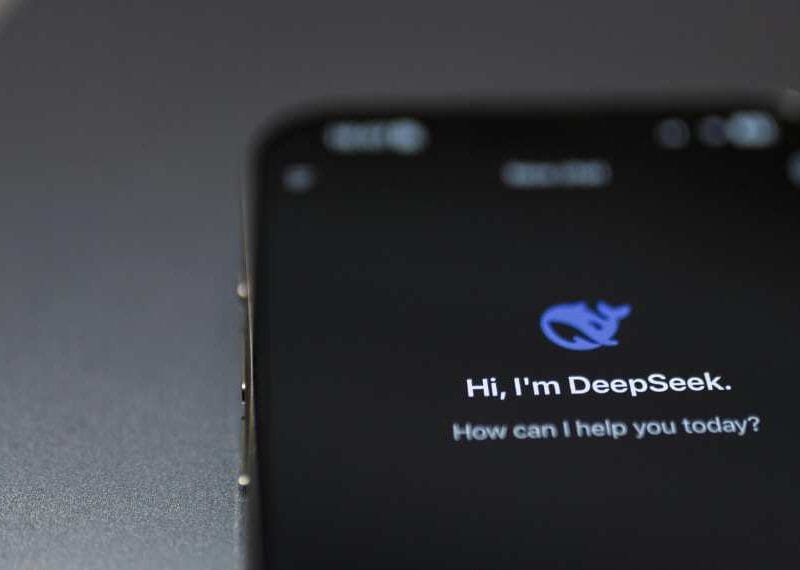Navigating AI’s Chaos: Top Leaders Reveal How to Strengthen Your Voice
The Artificial Intelligence revolution is not just on the horizon; it is actively reshaping industries and careers at an unprecedented pace.
This profound disruption has sparked widespread concerns about job displacement and the fundamental redefinition of work, making active and actionable thought leadership more crucial than ever before.
In a landscape increasingly saturated with AI-generated content and abstract futurism, what can leaders do to ensure their voices cut through the noise and offer genuine guidance?
This article compiles powerful insights from leading business executives, strategic thought leaders, and seasoned tech professionals.
They reveal core recommendations to strengthen impactful voices, focusing on authenticity, practicality, and human-centric approaches that can truly navigate and shape the future amidst AI’s transformative power.
Read on!
Miriam Groom
As AI continues to disrupt traditional roles and reshape industries at an unprecedented pace, the need for clear, compelling, and actionable thought leadership has never been more urgent.
At Mindful Career, we help professionals future-proof their careers and advise organizations on workforce transitions in an AI-driven economy. The stakes are high: inaction or passive commentary risks leaving millions of workers directionless and entire sectors vulnerable.
To strengthen thought leadership in the age of AI disruption, we must move from abstract futurism to grounded, strategic guidance. That means building a movement of professionals—HR leaders, technologists, ethicists, policymakers, and career coaches—who aren’t just reacting to AI but actively shaping how it integrates with human potential. Here’s how we can do that:
Anchor AI discourse in values, not just innovation.
AI isn’t just about tools; it’s about what kind of future we’re building. Strong thought leadership must be rooted in human-centric values like dignity of work, lifelong learning, and equitable access to opportunity.
Elevate voices from the front lines.
The best insights often come from people directly affected: displaced workers, educators retraining students, HR leaders redesigning job architectures. Amplifying these voices through panels, LinkedIn essays, or publications helps bring AI impact into practical focus.
At Mindful Career, we launched a webinar series titled AI and the Human Workforce in partnership with local career development associations. These sessions paired data scientists with job seekers and HR executives to discuss not just AI tools but also transition strategies.
One coach we collaborated with began publishing short weekly LinkedIn posts deconstructing AI’s impact on specific roles—from administrative assistants to UX designers—and offering immediate upskilling pathways. The response? Over 30% of her network engaged, many of whom booked sessions for one-on-one coaching.
AI doesn’t just demand innovation—it demands leadership. To strengthen thought leadership in this era, we must evolve from passive commentary to active engagement. That means offering frameworks, centering human stories, and creating communities of shared growth.
At Mindful Career, we believe that the future of work won’t just be powered by algorithms—it will be shaped by the courage and clarity of those willing to lead through disruption.
Marta Verma
I remember the first time AI threatened to make my job obsolete. That moment forced me to rethink what it means to be a thought leader in a world where algorithms can outpace us on facts and figures.
The secret sauce is not about being a walking encyclopedia anymore. It’s about being the storyteller, the connector, the person who can make sense of the chaos and help others feel seen and understood.
What really made a difference for me (and what I see working for others) is leaning into authenticity. Share your real experiences, your stumbles, your “aha!” moments. People crave that genuine human touch, especially now that AI is everywhere. Don’t be afraid to show your quirks and your failures. That’s what makes you relatable and memorable.
And don’t just talk to people, talk with them. The most influential voices today are building communities, not just audiences. They’re asking questions, inviting debate, and sparking conversations that matter. Use AI as your sidekick to help brainstorm or reach new people, but don’t let it drown out your unique perspective.
Above all, keep learning and adapting. The only thing AI can’t automate is your ability to grow, connect, and inspire. Your voice, with all its imperfections and passion, is exactly what the world needs right now. Don’t let the noise fool you—your human spark is irreplaceable.

Marta Verma
Business Partnerships Manager, Outstaff Your Team
Rauno Rüngas
If thought leadership is going to matter in times like this, it needs to move from theory to practice. The best way to strengthen those voices is by grounding them in real work and showing what you’re testing, what failed, what actually saved time or improved outcomes.
People are overwhelmed by big-picture takes. What they’re looking for is someone who’s in it, figuring it out in real time. That’s the kind of leadership that builds trust.
Skip the hype and vague predictions. Share specific use cases, small experiments, and honest lessons. That’s what makes a voice stand out and stay relevant as things keep changing fast.

Rauno Rüngas
CEO, Qminder
Vipul Mehta
To strengthen thought leadership in this space, the focus needs to shift from abstract debates about AI’s impact to practical, grounded guidance for industries and professionals facing disruption. A few ways to do that:
Anchor discussions in real-world context – Use case studies and data to show how AI is reshaping specific roles, and where new opportunities are emerging. This makes thought leadership actionable instead of theoretical.
Prioritize reskilling and transition pathways – Thought leaders should outline clear steps for adapting, whether it’s new skills, adjacent roles, or entrepreneurial options in AI-driven ecosystems.
Collaborate across disciplines – Bringing together technologists, domain experts, and policymakers creates balanced perspectives and avoids hype or fear-mongering.
Own a clear POV on ethics and responsibility – Voices that address AI’s risks head-on while offering solutions gain credibility and trust.
The strongest thought leaders are those who don’t just predict change but help people and organizations navigate it with confidence.

Vipul Mehta
Co-Founder & CTO, WeblineGlobal
Daniel Haiem
If we want thought leadership to truly hold the line in the face of AI’s breakneck pace, we have to stop playing it safe and start getting real. That means no more echo chambers, no more recycled LinkedIn posts, and definitely no more fluff.
The people who are going to shape the future aren’t the ones dropping buzzwords, they’re the ones who roll up their sleeves, take a stand, and build context around complexity.
My recommendation? Lead with lived experience. If you’re using AI, talk about what worked and what failed. Show the scars.
Thought leadership today needs less theory and more field notes. Publish pieces that teach, challenge, and spark conversation on platforms where your audience actually hangs out.
The real authority now comes from relevance, not just credentials. If your voice doesn’t provoke action or reflection, it’ll get drowned out in the AI noise. Be bold, be useful, be human.
Xi He
Recommendation: Create “Action-Oriented Authority” through 3 Unifying Pillars
Take a Confident, Unpopular Stand
– Why: Tasteless observations aren’t sufficient. Individuals have an ear for those who challenge assumptions and provide clarity in an era of dislocation.
– Action: Clarify where AI is overhyped versus underacknowledged in your industry. Repeat fears no more document them as decisions.
Turn Big Ideas into Tactical Playbooks
– Why: Human minds are bogged down. They need next steps, not theory.
– Action: Package insights into actionable frameworks, checklists, and “how-to” articles. Think productizing your thought leadership.
Use Multi-Format UGC and Co-Creation
– Why: Authoritative status rests on others repeating ideas and making them applicable.
– Action: Co-create with professionals on LinkedIn, Substack, or YouTube and reuse your POV in their settings. Ask followers to comment back with their own real-world spin on your frameworks.

Xi He
CEO, BoostVision
Jonathan Olson
Ways I can think of to enhance the thought-leading voices as AI shifts our workplaces are:
Make sharing simple for experts: Provide effortless methods for blogging, video creation, or participation in podcasts to experts.
Use plain English: Experts need to explain AI as if they are explaining it to a next-door neighbor, not to a fellow scientist. No technical terms
Diverse participation: We need to hear from educators, blue-collar professionals, physicians, retail supervisors, and not just technology specialists. They are the subject matter authorities.
Allow opposing views: Some people champion AI, and those who consider it a great danger. Both conversations need to happen without fearing reprisal.
Provide actions as the main focus: Instead of claiming “AI is terrifying”, intelligent people ought to recommend what actions can be taken.
Social media as a tool: Use it to promote, share, and distribute content using useful short, innovative sentences aimed at the audience.
Engage the community – Hold discussions in pre-existing gathering places like schools and community groups instead of high-profile lectures.
The goal should be getting more people talking about AI in ways that help everyone understand what is coming & what we can do about it.

Jonathan Olson
Entrepreneur, Quantum Scientist & Co-Owner, Quantum Jobs USA
Andy Danec
At Ridgeline Recovery, I’ve seen what happens when people lose their sense of identity—when something external shakes the ground they’ve built their lives on. That’s what AI is doing right now to a lot of professionals. And it’s not a distant threat—it’s personal. Real people. Real careers. Real livelihoods at risk of being reduced to automation.
So here’s my take: if your voice isn’t rooted in lived experience, it’s going to get drowned out. The only way to cut through the noise is to speak from the trenches. Don’t just post thought leadership—live it. Show people what you’ve walked through, what you’re seeing now, and where you’re leading next.
In mental health and addiction recovery, trust is earned through presence and practice—not perfect content. It’s no different in any other industry. If you want your voice to matter in this AI-saturated world, don’t try to sound smarter than the machine. Be more human than it can ever be.
My recommendation? Own your scars. Share the screw-ups, the pivots, the hard-earned wins. Lead with transparency, not polish. And don’t hide behind blanket takes—get specific. “Here’s what I’ve learned from doing the work. Here’s what I’m seeing right now. Here’s what needs to change.”
That kind of voice doesn’t just survive AI—it rises above it. Because when the world’s drowning in synthetic soundbites, the real thing stands out. And people can still tell the difference.
Raymond Anto
AI is disrupting industries with unstoppable force. To stay impactful, marketers must communicate clearly and act decisively. Thought leadership should move past clichés and empty promises, focusing on tangible outcomes and lessons from successes and setbacks alike. Authenticity resonates more than polished rhetoric.
Stay inquisitive about AI’s influence in your industry and don’t shy away from questioning mainstream views—it fuels deeper discussions. Foster a community around your ideas, engage in open debates, listen actively, and refine your message based on input.
Leadership isn’t a solo endeavor; it’s collaborative. The loudest voice doesn’t always prevail, but the most sincere one endures. So, dive in, be genuine, and keep the conversation vibrant. With heart and clarity, AI won’t overshadow true leaders.

Raymond Anto
Founder, Big Book Designs
On behalf of the Techronicler community of readers, we thank these leaders and experts for taking the time to share valuable insights that stem from years of experience and in-depth expertise in their respective niches.
If you wish to showcase your experience and expertise, participate in industry-leading discussions, and add visibility and impact to your personal brand and business, get in touch with the Techronicler team to feature in our fast-growing publication.














